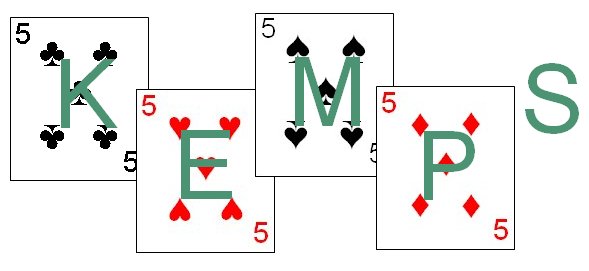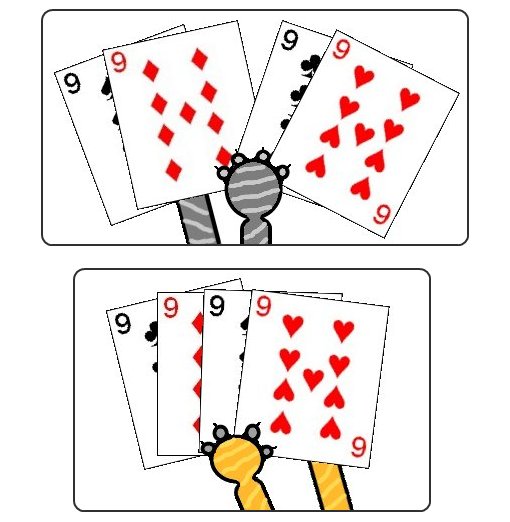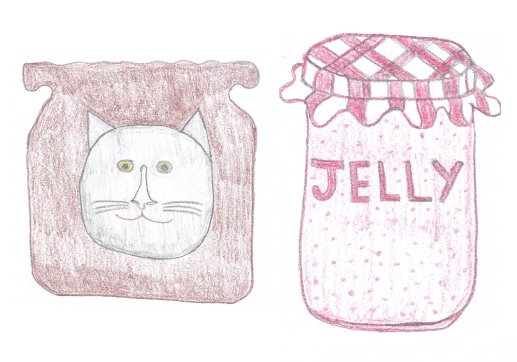
Kemps is a very fast moving, partnership card game where players attempt to signal their partner when they have four of a kind.
While traditionally played by four players in two partnerships, there are variants (described below) for more. Kemps is known by a number of additional names, including Camps, Cash, Kems and Kent.
The game of Kemps uses the standard 52 card deck. The suits and relative ranks of the individual cards are irrelevant in this game. The objective of Kemps and its many variants is to be the first team to shout "Kemps" after one of the members obtains four of a kind. However, the real challenge in this game is that the partner of the player who obtained the identical cards must be the one to actually shout the word "Kemps".
Seating positions and partnerships should be determined before play begins. A popular method of determining the first dealer is for all the participants to draw cards from a shuffled, face down deck. The players drawing the two highest ranked cards play as partners against those drawing the two lowest cards. Any players drawing cards of the same rank should draw two new cards from the pack. The player drawing the highest card of all is the first dealer, with the deal rotating in a clockwise rotation around the table for each subsequent hand.
Once the partnerships are determined both partnerships should confer amongst themselves in a location unobservable by the other partnership. They discuss and mutually agree on one or more secret signals. These signals are to help the partnership determine when one or the other player has four cards of the same denomination. They should decide on a signal that a player will make when he has the requisite four of a kind such that his partner will notice the signal and state "Kemps" to win the hand. These signals can be almost anything, a gesture, specific word or phrase or the way a player holds his cards. They players sometimes agree on several differing signals as well as potential "Fake" signals that might throw off the other team. Part of the challenge is to devise a signal that the other partner will detect but that the opponents will not, as they can pre-empt the shout of "Kemps", with a shout of their own ("Counter Kemps" or "Anti-Kemps").
Once both partnerships have had the opportunity to discuss their secret signal, they would then return to the table and take their seats. Each player should sit directly across the table from their partner, to help them notice when their partner makes the appropriate signal indicating they have four identically ranked cards.
Once everyone is seated at the table, the dealer than deals each player four face-down cards starting with the player to his immediate left and continuing in a clockwise rotation. The players should not pick up their cards until the dealer gives the start signal. Once each player has four face down cards, the dealer would deal four individual cards face-up near the center of the table.
Once these cards have been distributed the dealer would then state; "Ready", "Set", "Go". At the word "Go", all players would then pick up their hand and may begin swapping cards, one at a time with a card in the center of the table. There are no actual turns during the game, with everyone playing simultaneously. A player simply exchanges one card from his hand with one card from the center of the table. When a player exchanges a card, the card they place in the center of the table should be placed face up. If two or more players attempt to vie for the same card on the table, the first player to touch the card is entitled to take it.
Once a player manages to get four cards of the same rank in their hand, they would then attempt to give the signal such that their partner will detect the signal and shout "Kemps". In order to win, the partner of the player who actually obtained the four of a kind must state "Kemps", not the actual player obtaining it. However, if one of the opponents notices the signal before the players partner, they may instead say "Counter Kemps". When a player says "Kemps", the partner's hand would then be exposed to all in order to verify they actually had four of a kind. If so, they earn one letter in the word Kemps. However, if their partner does not actually have four of a kind, the opponents instead gain one letter.
 |
| Kemps players use a variety of signals to indicate they have four of a kind. In the top illustration, a player holds his cards in a V shape to attempt to notify his partner in secret that he has Kemps. In the lower picture, the player holds his cards closer together to indicate the same. |
However, as a twist, any member of the opponents partnership may also declare "Counter Kemps", indicating they believe a specific opponent has four of a kind. After shouting "Counter-Kemps" the player would then indicate the specific opponent whom they think has the four equally ranked cards. The indicated player must show their hand, and if the player stating "Counter Kemps" was correct his partnership earns one letter. If after saying "Counter Kemps", the indicated opponent does not have Kemps, the opponents partnership earns one letter instead.
If during the hand, all activity regarding the cards in the center of the table ceases, and no player yet calling "Kemps" or "Counter Kemps", the dealer would then remove the current four face up cards in the center of the table and replace them with four new ones from the remaining deck. The four cards removed are set aside, not used for the remainder of the hand. If the stock runs out and no one wants the last four cards exposed in the center, the hand ends with no score. This is usually called "Real Deal". All players throw their cards in, the same dealer then reshuffles and deals again.
The first partnership to successfully spell the word K-E-M-P-S, by earning all five letters over the course of multiple hands, is considered the winner.
Players are not allowed to adjourn and discuss a new secret signal until the end of the current game. Thus, players will often arrange more than one such signal in the event the opponents are able to determine what the secret signal might be. No hidden signals are allowed (i.e. talking in a foreign language not understood by all opponents or tapping your partner under the table). Aside from that rule, however, almost any signal is valid. Players will also often perform fake signals in order to bait the opponents into saying "Counter Kemps" before any player actually has Kemps.
Kemps is also known by a large number of alternative names, most of which are the exact same game. However, there are several games or variations which are somewhat different than the standard game.
Double Kemps: This version is played identically to the standard game. However, in addition to shouting "Kemps" a player may also state "Double Kemps" if they have four of a kind and think that their partner may also have four equally ranked cards. If they are correct in their statement of Double Kemps, their partnership gains two letters. However, if the player was incorrect in that both partners do not each have four of a kind, the opponents earn two letters.
Similarly, the opponents can state "Counter Double Kemps" if they believe each of their two opponents have four of a kind. If they were correct in that both opponents do have four equally ranked cards, they earn two letters. However, if they were wrong, and one or both opponents do not have four of a kind, those opponents score two letters.
In this version, the partnership would usually agree on a second signal to indicate Double Kemps than that for signalling Kemps itself.
No Verbal Signals: In this version, the secret signal may not include verbal elements. The signal must be based on a gesture, facial expression or some other non-spoken cue.
No Planning: This version of Kemps is usually much more challenging than the standard version. In this version, the players may not discuss or plan before the hand, and thus they must deliver their secret signals to their partner without any planning or foreknowledge.
Signal Discovered: Another variant sometimes played is to allow the players to change their signals between hands (rather than just between games). Thus, if a partnership believes that the opponents have determined their current secret signal, they can, after the current hand ends, excuse themselves from the table briefly and discuss for a different secret signal.
Run of Cards: In this version, the goal of the players is to collect a contiguous run of cards vice four cards of the same denomination. Once they have done so, as in the regular game, they would then attempt to signal their partner to shout "Kemps". The sequence ordering of cards in this version is as follows: Ace, 2, 3, 4, 5, 6, 7, 8, 9, 10, Jack, Queen, King.
Multi-Card Exchanges: When using this variant rule, a player may exchange more than one card at a time (up to four) to the center of the table. As in all versions of Kemps, however, a player may never have more than four cards in their hand at any one time.
Reverse Scoring: This variant is played the same way as in the standard version, the only difference being in scoring. In this version, the partnerships want to avoid earning letters in the word Kemps. Each time a partnership makes an incorrect statement of Kemps or Counter Kemps, the team making the incorrect statement earns one letter in the word Kemps. If a team spells out the entire word Kemps, the opposing team is declared the winner.
No Real Deal: This variant changes the behavior in the game when the situation for a Real Deal occurs. When playing this variant, once the stock has been exhausted, the dealer simply shuffles the cards that were previously set aside in the round and uses this to start a new stock. The dealer than continues the current hand, dealing out four cards to the center from the newly shuffled stock.
Kent: This version of Kemps is similar to the standard version, however with this variant, the players actually take individual turns rather than every player simultaneously trading cards from his hand with the center cards.
As in the standard version, both teams would confer in secret to devise a signal to indicate when one or the other of the partners have four of a kind. They would then return to the table and sit at the table, each player sitting directly across form his partner.
The dealer would then deal out the cards in a clockwise rotation one by one, until each player has a hand of four face down cards. However, unlike Kemps, in Kent the dealer does not place four cards face up in the center of the table. Instead, he places the remainder of the deck in a neat stack in the center of the table to form the stock. He would also take the top card of the stock and place it face up beside the stock pile.
The player to the dealer's immediate left has the first turn and the turn rotates around the table in a clockwise direction. On his turn each player then either draws a card from the stock or takes the top discard pile, adding the card to his hand. After doing so, he then discards any card of his choice from his hand to the top of the discard pile. When a player obtains four cards of the same rank, they would then, at some time attempt to make the secret signal. They may make this secret signal at any time, not just during their turn. The player's partner may also shout "Kemps" at any time, not just during his own turn. If a player shouts "Kemps" and his partner did in fact have four of a kind (proven by showing the hand), that partnership earns one letter in the word Kent. If they were incorrect, then the other team would score one letter instead. Also similar to Kemps, the opponents, at any time may shout "Counter Kemps" if they believe one of the opponents has four of a kind. The player shouting this must indicate the player who they believe has four of a kind. If correct, the partnership of the player saying "Counter Kemps" scores one letter in the word Kent. If they were wrong, however, the opposing team scores one letter instead.
The first partnership to earn enough letters to spell the full word KENT is the winner of the game.
Kemps for more players: Kemps can also be played by larger numbers of players, however it must always be an even number. There are two standard methods in which this is done, either with additional two player partnerships or partnerships consisting of 3 or more players each. Each method will be described below:
- Additional Partnerships: The most popular form of Kemps for additional players is to simply divide up the players into multiple two player partnerships. Each player should be seated between two opponents at the table. The game is played exactly the same as the standard version, save the fact there are more partnerships participating in each hand.
As in the standard game, if a player shouts "Kemps" and his partner did have four of a kind they add one letter. However, if they were incorrect, each opposing partnership scores one letter. At any time that an opposing team shouts "Counter Kemps", they must indicate the specific player who they believe has four of a kind. If correct, they score one letter. However, if the indicated player did not actually have four of a kind, the partnership to which they falsely indicated had the four of a kind earns one letter instead.
- Larger Partnerships: Another version of Kemps sometimes played is to evenly divide the players into two partnerships of equal size. The players should be seated such that every player is seated between two opponents.
In this version, at least half of the players on a partnership must have four of a kind before another member of the partnership can shout "Kemps". Once "Kemps" is shouted by any member of the partnership, all members of that partnership would expose their hands. At least half of the players (not counting the player who shouted "Kemps") must have four of a kind to earn one letter. If this is not the case the opponent partnership earns one letter instead. Similarly, when a member of the opposing partnership shouts "Counter Kemps", at least half of the members of the opposing team must have had Kemps for the addition of a letter. If not, the opposing partnership earns one letter instead.
Another difference when played by partnerships of more than four players is that each player is dealt five cards per hand instead of four. This serves to make it more difficult for the opposition to detect when one member of a partnership might have four of a kind.
Other Names: There are a large number of games that are played identically to Kemps but with varying names. The main difference in these games is the words shouted to indicate certain hands. The following are just a few of these:

- Peanut Butter and Jelly: In this version, a player would state "Peanut Butter" when they believed their partner had four of a kind. If a player thought the opponents instead had four of a kind they would shout "Jelly". Also in this variant, rather than spell a specific word, each team simply earns points for correct statements of Peanut Butter or Jelly. The first partnership to score four points wins the round.
- Signal: This version is also played identically to the standard version. In this version, a player who believes his partner has four of a kind would shout "Signal". When a player believes the opposing partnership has the four of a kind instead, they would shout "Cut". When playing this version, the rules allow a player to discard and take multiple cards from the center. Rather than attempt to spell a specific word, the players would simply earn one point for correct statements of Signal or Cut, with the first partnership reaching 4 points declared the winner.
Copyright © 2015 CatsAtCards.com. All rights reserved.
 Kemps is a very fast moving, partnership card game where players attempt to signal their partner when they have four of a kind.
While traditionally played by four players in two partnerships, there are variants (described below) for more. Kemps is known by a number of additional names, including Camps, Cash, Kems and Kent.
Kemps is a very fast moving, partnership card game where players attempt to signal their partner when they have four of a kind.
While traditionally played by four players in two partnerships, there are variants (described below) for more. Kemps is known by a number of additional names, including Camps, Cash, Kems and Kent.
